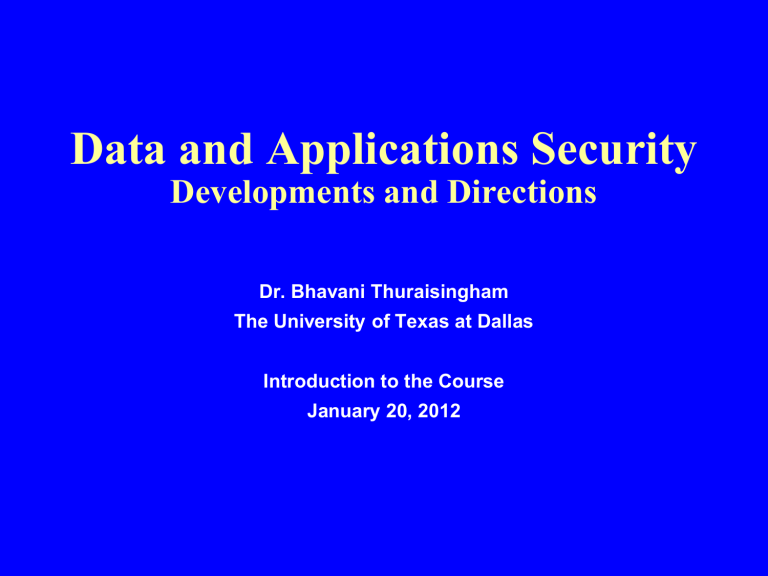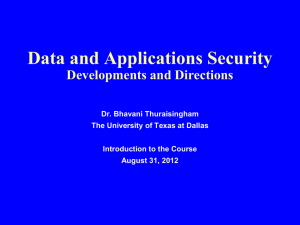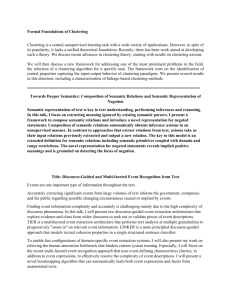Introduction - The University of Texas at Dallas

Data and Applications Security
Developments and Directions
Dr. Bhavani Thuraisingham
The University of Texas at Dallas
Introduction to the Course
January 20, 2012
Objective of the Unit
This unit provides an overview of the course. The course describes concepts, developments, challenges, and directions in data and applications security. Topics include
database security, distributed data management security, object security, data warehouse security, data mining for security applications, privacy, secure semantic web, secure digital libraries, secure knowledge management and secure sensor information management, biometrics
Outline of the Unit
Outline of Course
Course Work
Course Rules
Contact
Outline of the Course
Unit #1: Introduction to Data and Applications
Part I: Background
-
Unit #2: Data Management
-
Unit #3: Information Security
-
Unit #4: Information Management
Part II: Discretionary Security
-
Unit #5: Concepts
-
Unit #6: Policy Enforcement
Part III: Mandatory Security
-
Unit #7: Concepts
-
Unit #8: Architectures
Outline of the Course (Continued)
Part IV: Secure Relational Data Management
-
Unit #9: Data Model
-
Unit #10: Functions
-
Unit #11: Prototypes and Products
Part V: Inference Problem
-
Unit #12: Concepts
-
Unit #13: Constraint Processing
-
Unit #14: Conceptual Structures
Part VI: Secure Distributed Data Management
-
Unit #15: Secure Distributed data management
-
Unit #16: Secure Heterogeneous Data Integration
-
Unit #17: Secure Federated Data Management
Outline of the Course (Continued)
Part VII: Secure Object Data Management
-
Unit #18: Secure Object Management
-
Unit #19: Secure Distributed Objects and Modeling Applications
-
Unit #20: Secure Multimedia Systems
Part VIII: Data Warehousing, Data Mining and Security
-
Unit #21: Secure Data Warehousing
-
Unit #22: Data Mining for Security Applications
-
Unit #23: Privacy
Part IX: Secure Information Management
-
Unit #24: Secure Digital Libraries
-
Unit #25: Secure Semantic Web (web services, XML security)
-
Unit #26: Secure Information and Knowledge Management
Outline of the Course (Continued)
Part X: Emerging Technologies
-
Unit #27: Secure Dependable Data Management
-
Unit #28: Secure Sensor and Wireless Data Management
-
Unit #29: Other Emerging Technologies
Unit #30 Conclusion to the Course
Guest Lectures Some guest lectures may be included
Some other topics
Review for exams
Course Work
2 Exams: 20 points each
-
Exam #1: March 9; Exam #2: May 4
Programming Project and demonstration, 16 points
-
April 27
Term Paper and presentation: 12 points
-
April 13
4 Homework assignments: 8 points each
-
February 17, March 2, March 30, April 20
Some Topics for Papers
XML Security
Inference Problem
Privacy
Secure Biometrics
Intrusion Detection
E-Commerce Security
Secure Sensor Information Management
Secure Distributed Systems
Secure Semantic Web
Secure Data Warehousing
Insider Threat Analysis
Secure Multimedia Systems
Term Papers: Example Format
Abstract
Introduction
Background on the Topic
Survey of various techniques, designs etc,
Analyze the techniques, designs etc. and give your opinions
Directions for further work
Summary and Conclusions
References
Term Papers: Example Format - II
Abstract
Introduction
Background on the Topic and Related Work
Discuss strengths and weaknesses of your work and others’ work
Give your own design
Directions for further work
Summary and Conclusions
References
Project Report Format
Overview of the Project
Design of the System
Input/Output
Future Enhancements
References
Some Project Topics
Quivery Modification on XML Documents
Access control for web systems
Intrusion detection system
Access control for multimedia systems
-
E.g., access control for image, video
Role-based access control system
Access control for object systems
Secure data warehouse
Course Rules
Course attendance is mandatory; unless permission is obtained from instructor for missing a class with a valid reason
(documentation needed for medical emergency for student or a close family member – e.g., spouse, parent, child). Attendance will be collected every lecture. 5 points will be deducted out of 100 for each lecture missed without approval.
Each student will work individually
Late assignments will not be accepted. All assignments have to be turned in just after the lecture on the due date
No make up exams unless student can produce a medical certificate or give evidence of close family emergency
Copying material from other sources will not be permitted unless the source is properly referenced
Any student who plagiarizes from other sources will be reported to the appropriate UTD authroities
Contact
For more information please contact
-
Dr. Bhavani Thuraisingham
-
Professor of Computer Science and
-
Director of Cyber Security Research Center Erik Jonsson School of Engineering and Computer Science EC31, The University of
Texas at Dallas Richardson, TX 75080
-
Phone: 972-883-4738
-
Fax: 972-883-2399
-
Email: bhavani.thuraisingham@utdallas.edu
-
URL: http://www.utdallas.edu/~bxt043000/
Papers to Read for Exam #1
Multilevel Object Security
-
Bhavani M. Thuraisingham: Mandatory Security in Object-
Oriented Database Systems. OOPSLA 1989 : 203-210
Distributed Inference Control
-
Bhavani M. Thuraisingham, William Ford : Security
Constraints in a Multilevel Secure Distributed Database
Management System. IEEE Trans. Knowl. Data Eng. 7 (2):
274-293 (1995)
Secure Geospatial Systems
-
Elisa Bertino, Bhavani M. Thuraisingham, Michael Gertz ,
Maria Luisa Damiani : Security and privacy for geospatial data: concepts and research directions. SPRINGL 2008 : 6-
19
Additional papers for assignment 1
Index to Lectures for Exam #1
Lecture 1: Introduction (this unit)
Lecture 2: Security Modules
Lecture 3: Data, Info and Knowledge Management
Lecture 4: Access Control
Lecture 5: Policies
Lecture 6: Assignment #1
Lecture 7: Multilevel Database Management
Lecture 8: Dr. Hamlen guest lecture
Lecture 9: Inference Problem 1
Lecture 10: Inference Problem 2
Lecture 11: Assignment #2
Lecture 12: Secure distributed, heterogeneous, federated data
Lecture 13: Secure objects
Papers to Read for Exam #2
Elisa Bertino , Barbara Carminati , Elena Ferrari , Bhavani M.
Thuraisingham, Amar Gupta : Selective and Authentic Third-Party
Distribution of XML Documents. IEEE Trans. Knowl. Data Eng.
16 (10): 1263-1278 (2004)
Timothy W. Finin , Anupam Joshi , Lalana Kagal , Jianwei Niu , Ravi S.
Sandhu , William H. Winsborough , Bhavani M. Thuraisingham:
ROWLBAC: representing role based access control in OWL.
SACMAT 2008 : 73-82
Barbara Carminati , Elena Ferrari , Raymond Heatherly , Murat
Kantarcioglu , Bhavani M. Thuraisingham: A semantic web based framework for social network access control. SACMAT 2009 : 177-186
Jungin Kim , Bhavani M. Thuraisingham: Dependable and Secure
TMO Scheme. ISORC 2006 : 133-140
Index to Lectures for Exam #2
Lecture 14: Data warehousing, data mining and security
(March 2, 2012)
Lecture 15: Blank
Lecture 16: Privacy (March 9, 2012)
Lecture 17: Assignment #3
Lecture 18: Lecture by Dr. Tahseen (March 23, 2012)
Lecture 19: Data Mining for Malware detection (March 23,
2012)
Lecture 20: Attacks to databases (March 23, 2012)
Lecture 21: Threats to info security by Dr. Goel (Module 1 only)
Lecture 22: Intro to semantic web (March 30, 2012)
Lecture 23: Trustworthy semantic web (March 30, 2012)
Index to Lectures for Exam #2
Lecture 24: Secure Third Party Publication of XML data (April
6, 2012)
Lecture 25: NIST Project, Guest lecture Ms. Jyothsna (April 6)
Lecture 26: Security for web services (April 13, 2012)
Lecture 27: Secure Social Networks (April 13, 2012)
Lecture 28: Comprehensive overview of cloud computing
(April 20, 2012)
Lecture 29: Secure knowledge management and web security
(April 13, 2012)
Lecture 30: Assured Cloud Computing (April 20, 2012)
Lecture 31: Assignment #4
Lecture 32: Dependable data management (April 27, 2012)
Lecture 33: Digital Forensics and Biometrics (April 27, 2012)
Lecture 34: Lecture by Dr. Neda (given on April 20, 2012)
What have we learned in the course?
Module 1: Cyber Security, Data management, Data Security Intro
Module 2: Discretionary security and policy management for data
Module 3: Multilevel secure data management
Module 4: Distributed, Heterogeneous and federated data management and Assured Information Sharing
Module 5: Secure object and multimedia management
Module 6: Data warehousing, Data Mining for security (malware) and
Privacy Aspects
Module 7: Semantic Web and Security
Module 8:Secure web services, Secure Knowledge Management and
Social networking
Module 9: Secure Cloud Data Management
Module 10: Secure Dependable and Real-time data management
Module 11: Misc topics: Digital Forensics, Biometric cs, etc.





